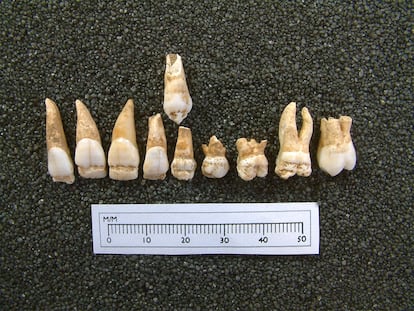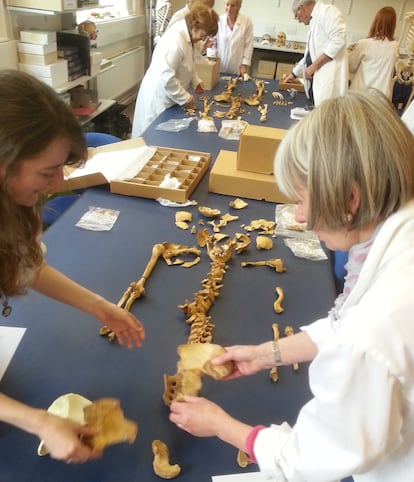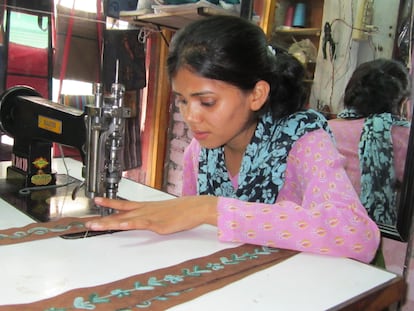Unearthed remains of dozens of children reveal Industrial Revolution’s cruelty
A study of bones and teeth from the 19th century – recently unearthed in the United Kingdom – shows that children suffered from physical punishment, stunted growth and malnutrition

In works by Charles Dickens, such as Oliver Twist or Great Expectations, the story of orphaned children living under harsh conditions is told with no holds barred. The author paints a detailed picture of minors who grew up in the hostile environment that was the early-19th century United Kingdom, with the Industrial Revolution in full swing. Hunger and misery were the norm for children who were forced to toil in factories.
Today, a group of scientists has analyzed the remains of dozens of children from that era, by using modern forensic techniques. They have managed to confirm the stories told by the classic writer. The study shows that many working children grew up and died in a state of malnourishment. The physical development of those who were 12-years-old corresponded to that of eight-year-olds. The corpses are also marred by bone injuries compatible with physical punishment.
It turns out that the truth was even harsher than the fiction narrated by the master of social realism. While Dickens’ characters grow older and have a relatively happy ending, many in this study – published in the scientific journal PLOS ONE – did not even make it past adolescence.
A few years ago, the construction of a local museum next to Fewston Church – located in the Washburn region of central England – made it necessary to unearth a large part of the old cemetery. A company was hired – one that specialized in archaeological excavations. Nobody had any idea about what they were going to discover.
“My company – York Osteoarchaeology – undertook the osteological analysis of the skeletons, determining the age, sex and pathologies of the people buried at Fewston,” says Malin Holst, an archaeologist at the University of York and co-author of the study. “It was during this initial skeletal analysis that it became clear that there were a lot of adolescents… something not very common in cemeteries.”
In today’s cemeteries, most of those who are buried tend to be older. However, in the past – before the advances in modern medicine and social protections – the pattern was different: along with the elderly, there were also many graves belonging to newborns and young children, who had been swept away by illness. But in Fewston, 54 of the 154 bodies recovered from the first half of the 19th-century were boys and girls between the ages of seven and 20. Such a strange figure resulted in a need for further investigation.
The osteological study allowed the scientists to determine how much these children suffered. Most of them had died at an age (determined by the teeth) that did not correspond to the length and state of development of their bones. For example, an individual identified as SK 331 would have been between the age of 12 and 14-years-old according to his teeth… but the bones correspond to those of a child no more than eight-years-old. Meanwhile, a girl identified as SK 262 died between the ages of 16 and 18, but her bones – lacking the characteristic that indicates the end of bone growth (epiphyseal fusion) – correspond to the development of the average 10-year-old girl.
Malnutrition was confirmed by the lack of growth – a condition known as hypoplasia – found through the children’s teeth. This pathology of the enamel – characterized by its incomplete development – generally occurs in childhood, caused by a poor diet and the accumulation of diseases. This type of stress at an early age also affects brain development, as studies with children from orphanages in Romania under the brutal Ceaucescu dictatorship (1965-89) have shown.
“Some of the children suffered from rickets and scurvy. We can diagnose these conditions because they leave traces in the bones,” says Rebceca Gowland, a Durham University bioarchaeologist and first author of the study. One of these traces is the lack of vitamins – something essential in the early phases of child development. “A vitamin D deficiency involves some bowing of the long bones and other changes. As for vitamin C deficiency, it generally manifests itself in the form of porous lesions in certain parts of the skeleton,” she explains.
To confirm malnutrition, the researchers looked at carbon and nitrogen isotopes. The differences in the proportion of the isotope nitrogen-15 and carbon-13 allow us to know the relative weight of the proteins of animal and vegetable origin in an individual’s diet. The low levels of this ratio that the researchers found in almost all the youngsters indicate that they died after many years of a diet with little or no meat or animal-derived foods, such as dairy products.

York archaeologists brought the remains to the bioarchaeology laboratory belonging to their colleagues at Durham University. Between them, they used sophisticated forensic techniques to analyze all the bodies. Many of the elderly buried – as well as one young child – were identified thanks to their tombstones or the plaques that were placed on the coffins. But the young were almost all in unmarked graves. The scientists were able to determine their age at death thanks to the development of their teeth – but they also had to find out who they were and where they came from. One of the few tools to learn the origins of an unknown person is to extract the proteins present in dental enamel and analyze the ratio of different chemical elements present. Two of the most fruitful are the isotopes of strontium and oxygen.
“As we develop our teeth, the chemical ratios of strontium and oxygen within them reflect the local geology and the water we drink,” says Gowland. “We knew that the skeletons were not local, because the strontium and oxygen isotope values were very different from those observed in the teeth of individuals known to hail from the region. Instead, for many of the children, [the chemicals] were coincidental with London and its surrounding areas.”
During the beginnings of the Industrial Revolution – at the end of the 18th century and the first part of the 19th century – there was a great migration from the countryside to industrial cities, such as Leeds or Manchester. But it also happened in the opposite direction, with residents – especially children – of the poorest neighborhoods of London or Liverpool shifting to rural areas where many factories were being set up, especially related to the textile industry. In Fewston, there were five, with the largest – the West House Mill – engaged in spinning linen and cotton.
Several indentures have been found in the town’s archives: contracts between the West House patrons and orphaned children (or children abandoned by their parents) from London. These documents forced the little ones to work in exchange for a bed, food and education until they were 21-years-old or, in the case of girls, until they were married. These asylums were known as “workhouses.” Oliver Twist begins his story in one of these terrible places.
The picture the research paints coincides with the memoirs of the Reverend Robert Collyer, who was at West House between the ages of eight and 14: “They called at six in the morning and we left at eight in the night, with only an hour to eat and rest. We had the opportunity to sit for a few moments when the supervisor was not around to punish our little shoulders with his leather strap [...] and the result of all this was that the weaker children were so crippled that the memory of their twisted limbs still sheds a rather sinister light for me on the Holy Scriptures,” he recalls, in a fragment recovered by the authors of this investigation.
“[The remains found at Fewston] have been the only ones excavated from a rural cemetery in the north of England… this is unusual,” Gowland replies, when asked if the story of these children is anecdotal or representative of the beginnings of the Industrial Revolution. “But there are many rural cemeteries like Fewston. However, they are rarely excavated, because this only happens if [the property is] going to be redeveloped,” he adds.
Two pieces of information can frame the scope of the drama: official statistics mentioned in the study estimate that 195,000 children between the ages of five and 14 passed through one of the parish hospices in 1803. And, in 1845, in the cotton sector, 45% of the workers were under the age of 18.
As for the Fewston children, once their bones told scientists what they had suffered, they were properly reburied. Their story is preserved at the Washburn Heritage Centre.
Sign up for our weekly newsletter to get more English-language news coverage from EL PAÍS USA Edition
Tu suscripción se está usando en otro dispositivo
¿Quieres añadir otro usuario a tu suscripción?
Si continúas leyendo en este dispositivo, no se podrá leer en el otro.
FlechaTu suscripción se está usando en otro dispositivo y solo puedes acceder a EL PAÍS desde un dispositivo a la vez.
Si quieres compartir tu cuenta, cambia tu suscripción a la modalidad Premium, así podrás añadir otro usuario. Cada uno accederá con su propia cuenta de email, lo que os permitirá personalizar vuestra experiencia en EL PAÍS.
¿Tienes una suscripción de empresa? Accede aquí para contratar más cuentas.
En el caso de no saber quién está usando tu cuenta, te recomendamos cambiar tu contraseña aquí.
Si decides continuar compartiendo tu cuenta, este mensaje se mostrará en tu dispositivo y en el de la otra persona que está usando tu cuenta de forma indefinida, afectando a tu experiencia de lectura. Puedes consultar aquí los términos y condiciones de la suscripción digital.
More information
Archived In
Últimas noticias
Most viewed
- Sinaloa Cartel war is taking its toll on Los Chapitos
- Oona Chaplin: ‘I told James Cameron that I was living in a treehouse and starting a permaculture project with a friend’
- Reinhard Genzel, Nobel laureate in physics: ‘One-minute videos will never give you the truth’
- Why the price of coffee has skyrocketed: from Brazilian plantations to specialty coffee houses
- Silver prices are going crazy: This is what’s fueling the rally











































